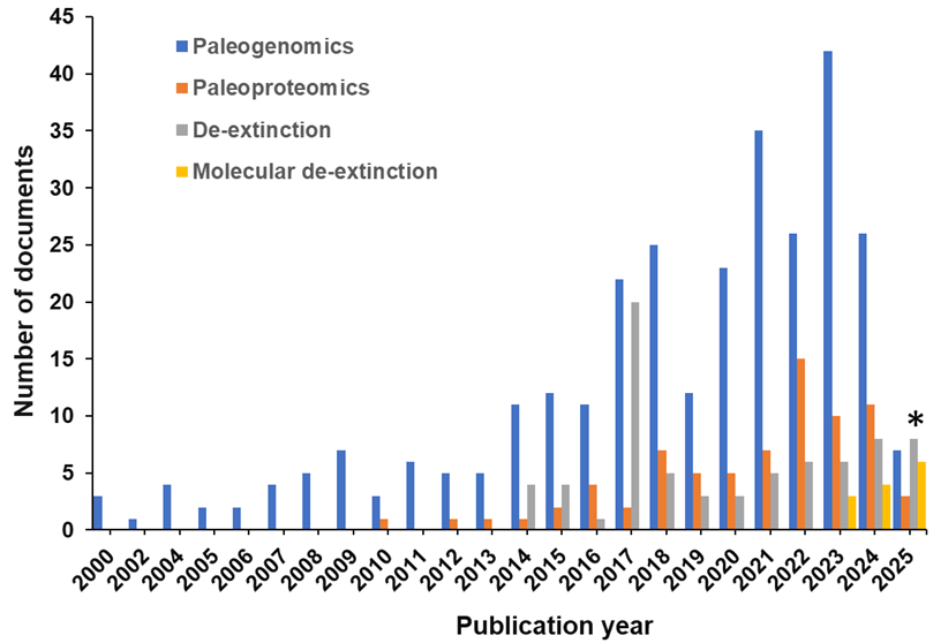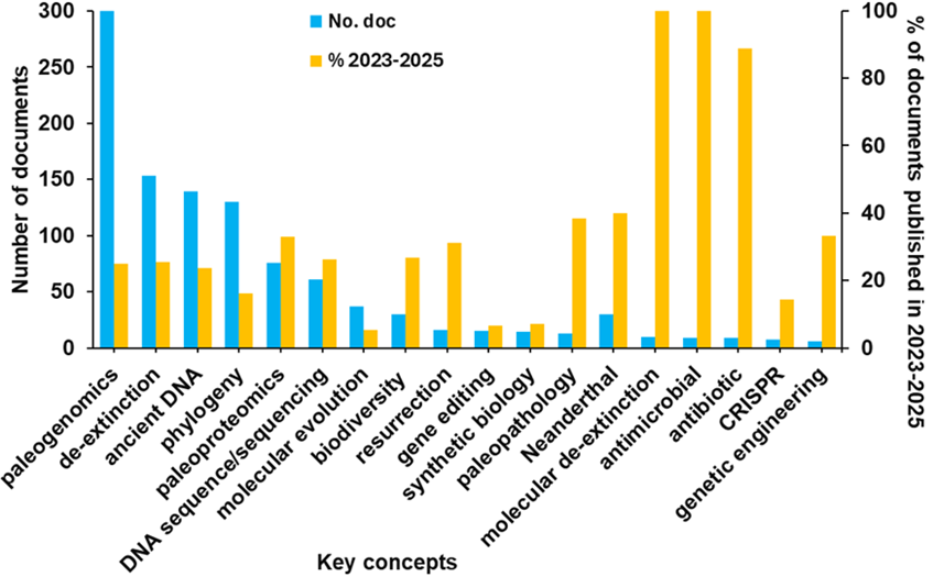In early 2025, scientists announced they had brought back dire wolves from extinction with three gene-edited wolf pups. The media excitement may have obscured some key details — notably the modification of extant grey wolf genomes with only certain dire wolf gene edits — but it showed the possibilities of advanced genetic technologies to revive genes thought to be permanently lost.
Rather than bring back extinct species, however, a more immediate and manageable application of this technology is molecular de-extinction, which is the selective resurrection of extinct genes, proteins, or metabolic pathways. This emerging field leverages two primary scientific disciplines: paleogenomics, the study of ancient DNA (aDNA), and paleoproteomics, the analysis of ancient proteins preserved in fossilized and subfossil remains.
These approaches allow scientists to mine evolutionary history for novel bioactive compounds that could revolutionize medicine, biotechnology, and synthetic biology. Specifically, molecular de-extinction could address issues with antibiotic resistance by providing unconventional sources of antimicrobial molecules.
Recent technological advancements have propelled molecular de-extinction from theoretical speculation to experimental reality. Next-generation sequencing (NGS) and third-generation long-read sequencing have dramatically improved the recovery of fragmented aDNA, while high-resolution mass spectrometry and bioinformatic protein modeling allow researchers to reconstruct ancient protein sequences and predict their functions.
With progress in computational biology and AI, the identification of favorable molecules has transitioned from a largely random process to a more deliberate, data-driven methodology, where researchers can target specific molecular characteristics based on extensive data analysis to predict their potential efficacy.
Research trends in molecular de-extinction
We analyzed the CAS Content CollectionTM, the largest human-curated repository of scientific information, to understand the current landscape and research progress in molecular de-extinction. We found that documents have increased in the last ten years, with one patent during that time (see Figure 1).

This analysis reveals that the peak of de-extinction-related documents in 2017 is connected to The Hastings Center for Bioethics publishing a special issue, Recreating the Wild: De‐Extinction, Technology, and the Ethics of Conservation. We also examined essential concepts related to de-extinction in the literature (see Figure 2).

The major takeaways from the research landscape today are:
- Paleogenomics is the most explored concept. While other approaches (e.g., back-breeding or cloning) contribute to de-extinction, paleogenomics provides the genetic roadmap necessary for precise species revival. By recovering, sequencing, and analyzing genetic material from extinct species, researchers can reconstruct lost genomes, identify key functional adaptations, and engineer living proxies through genome editing. Advances in high-throughput sequencing, CRISPR-Cas9 gene editing, and synthetic biology are converging to make substances and species revival a tangible — albeit complex — scientific endeavor.
- Antimicrobials and antibiotics are the subject of the most molecular de-extinction-related documents in the last three years (accounting for 2025 data only through March). Three key intersections are noteworthy: (1) ancient antimicrobial peptide discovery through paleogenomics, (2) CRISPR-based antimicrobial strategies developed from de-extinction tools, and (3) novel antibiotic discovery from resurrected microbial communities.
- Paleopathology, the study of ancient diseases, co-occurs with de-extinction. Paleopathology is traditionally focused on understanding health in past populations through skeletal and mummified remains. However, recent advances in paleogenomics, paleoproteomics, and bioinformatics have expanded its applications into modern drug discovery. By analyzing ancient pathogens, human immune responses, and extinct medicinal compounds, researchers are uncovering novel therapeutic strategies to combat antibiotic resistance, chronic diseases, and emerging infections. Furthermore, integrating evolutionary biology with paleopathology offers a better understanding of selective pressures that affected cancer susceptibility in extinct species and could identify potential mechanisms of tumor resistance.
- Genome-scale data on Neanderthals have been made available for the skeletal remains from fourteen archaeological sites spanning Neanderthal history across large parts of their identified geographical areas.
Methodologies of molecular de-extinction
As noted, there are two approaches to de-extinction: paleogenomics, which studies aDNA, and paleoproteomics, which studies ancient proteins. Each has led to important breakthroughs in identifying potential antimicrobial treatments.
Paleogenomics
The idea of de-extinction has transitioned from science fiction to a tangible scientific pursuit thanks to advances in paleogenomics. This approach has already yielded functional insights into evolutionary biology, such as the cold-adaptation mechanisms of Pleistocene megafauna, the neurogenetic differences between modern humans and Neanderthals, and the immune system evolution of extinct pathogens.
Paleogenomics even helps us understand our response to current pathogens. For example, a study of immune genes of Neanderthals rationalized our susceptibility to emerging infectious diseases such as COVID-19. A gene cluster on chromosome 3, identified as the major genetic risk factor for respiratory failure after infection with SARS-CoV-2, was conferred by a genomic segment inherited from Neanderthals and has been found to be carried by about 50% of people in South Asia and 16% of people in Europe.
The paleogenic process aims to revive genes from extinct species by reconstructing their genomes and introducing them into closely related living organisms, such as in the aforementioned dire wolf example. The first and most crucial step is obtaining high-quality aDNA from preserved biological material, followed by DNA isolation, next-generation sequencing, and computational genetic assembly.
Unlike modern DNA, aDNA is highly degraded, chemically modified, and often contaminated with microbial and environmental DNA. Advances in DNA extraction, sequencing technologies, and bioinformatics have made it possible to recover and analyze aDNA, paving the way for de-extinction efforts.
Bringing back fully formed animals like dire wolves or woolly mammoths involves many practical and ethical challenges. Animal welfare and ecological consequences are just two of the complex issues around species de-extinction. Bringing back ancient peptides, however, is much less fraught and can drive drug discovery efforts. Through paleogenomics, researchers identified eight extinct vertebrate genomes and have computationally verified them for defensins, which are small, disulfide-rich cationic peptides that play important roles in host immunity.
Six authentic β-defensins have been identified as a result, five of which are derived from two different extinct bird species and one from a mammalian species. The evolutionary and structural analyses of these molecules are opening new avenues for antibiotic discovery, although they have not yet been experimentally validated.
Paleoproteomics
Molecular de-extinction via paleoproteomics involves the extraction, sequencing, computational reconstruction, and functional resurrection of proteins from extinct organisms. This methodology leverages advances in mass spectrometry, bioinformatics, and synthetic biology to recover and study ancient biomolecules.
For example, scientists used deep learning models to discover new antibiotic peptides. Models for proteolytic site prediction were trained to project antimicrobial activity by a large range of proteases in the proteomes of extinct organisms (so called “extinctome”). A large collection of sequences not found in extant organisms were predicted to exhibit broad-spectrum antimicrobial activity. Of these, 69 peptides were synthesized and their activity against bacterial pathogens was experimentally verified. A selection of active antimicrobial peptides is shown in Table 1.
Several pairs of peptides from the same extinct organism exhibited strong synergistic interactions against pathogens such as A. baumannii and P. aeruginosa, with fractional inhibitory concentration (FIC) index values as low as 0.38 for A. baumannii. For the combination of Equusin-1 and Equusin-3, the minimum inhibitory concentrations (MICs) decreased by 64 times (from 4 μmol L-1 to 62.5 nmol L-1), reaching sub-micromolar concentrations that are comparable to the MICs of most potent antibiotics.
Remarkably, top compounds, including Mammuthusin-2, Elephasin-2, Hydrodamin-1, Mylodonin-2, and Megalocerin-1, exhibited potential anti-infective activity in mice with skin abscess or thigh infections. The results obtained for the more active peptides tested in the skin abscess infection model (Elephasin-2 and Mylodonin-2) indicated antibacterial activity comparable to that of the widely used antibiotic polymyxin B. Similarly, Mylodonin-2 and Elephasin-2 exhibited comparable anti-infective efficacy to polymyxin B when using a murine deep thigh infection model, thus underscoring the potential of molecular de-extinction as a successful approach for antibiotic discovery.
A recent patent disclosed the methods for identifying antimicrobial peptides derived from extinct proteomes using a multitask deep learning algorithm, APEX, along with the identified 41 antimicrobial peptides and their synergy and mechanism of action.
Furthermore, the created machine learning tool, panCleave random forest model for proteome-wide cleavage site prediction, explored a pan-protease cleavage site classifier to perform computational proteolysis — an in silico digestion of human proteins. Machine learning approaches were therefore used for molecular de-extinction and mined the proteomes of our closest relatives, the archaic humans Neanderthals and Denisovans. Several encrypted peptide antibiotics were resurrected, which displayed antimicrobial activity in vitro and in preclinical mouse models.
Potential breakthroughs in antibiotics
To understand what the ancestor of today’s glycopeptide antibiotics may have looked like, researchers used bioinformatics and genetic and biochemical methods to bring the ancestral “paleomycin” back to life. First, the non-ribosomal peptide synthetase assembly line of paleomycin was predicted and a guide tree based on biosynthetic gene clusters was constructed. Subsequently, by employing synthetic biology techniques, researchers reconstructed the predicted peptide and validated its antibiotic activity.
This study proved that the combination of synthetic biology and computational techniques can determine the temporal evolution of antibiotics and potentially revive ancient molecules. It also demonstrated the natural optimization tactics achieved through evolutionary processes that resulted in modern glycopeptide antibiotics, thus laying the foundation for future efforts to engineer this important class of antimicrobial agents.
Scientists are also exploring the possibility of finding new sources of antibiotics in Neanderthal cathelicidins. This is a family of antimicrobial peptides similar to those found in modern humans, which play a role in defending against infections. Researchers have developed a machine learning model that can mine proteomic and genomic data from Neanderthals and Denisovans, essentially finding sequences from archaic humans and predicting which ones would be viable antibiotic candidates.
Challenges and opportunities in de-extinction
Molecular de-extinction may present fewer logistical and ethical dilemmas than resurrecting extinct animals and reintroducing them into modern ecosystems. However, it is not without certain risks, such as:
- DNA degradation and incomplete genomic data making full gene reconstruction difficult.
- Functional uncertainty of resurrected molecules, including protein folding errors, post-translational modifications, toxicity, and immunogenicity.
- Gene silencing, off-target effects, and horizontal gene transfer, where engineered genes could spread uncontrollably in ecosystems and have unintended impacts.
- Bioethical questions on whether extinct molecules should be commercialized.
Ethical frameworks and collaboration between the scientific and regulatory communities will be vital to guide many of these considerations. In terms of potential scientific hurdles, advanced technologies will continue to play a key role. AI can simulate how proteins fold and function, bypassing the need for complete DNA sequences. Neural networks can predict missing fragments in degraded ancient DNA and improve reconstruction accuracy. CRISPR-Cas9 and base editing can potentially "humanize" ancient genes for safe medical use.
Molecular de-extinction represents a paradigm shift in antibiotic discovery, offering a unique reservoir of unexploited antimicrobial potential. While challenges remain in scaling and regulation, early successes demonstrate that Earth’s lost biodiversity may hold the key to solving the antimicrobial resistance crisis.
For more information, see our article in ACS Omega, Molecular Paleontology Meets Drug Discovery: The Case for De-extinct Antimicrobials.
References:
2: https://www.nature.com/articles/s41551-024-01201-x?utm_source=acs&getft_integrator=acs







